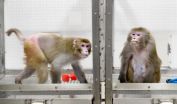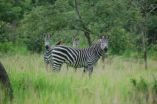(Press-News.org) Researchers from the University of California, San Diego Skaggs School of Pharmacy and Pharmaceutical Sciences, in collaboration with materials scientists, engineers and neurobiologists, have discovered a new mechanism for using light to activate drug-delivering nanoparticles and other targeted therapeutic substances inside the body.
This discovery represents a major innovation, said Adah Almutairi, PhD, associate professor and director of the joint UC San Diego-KACST Center of Excellence in Nanomedicine. Up to now, she said, only a handful of strategies using light-triggered release from nanoparticles have been reported.
The mechanism, described in the April 1, 2014 online issue of ACS Nano, employs near-infrared (NIR) light from a low-power laser to heat pockets of water trapped within non-photo-responsive polymeric nanoparticles infused with drugs. The water pockets absorb the light energy as heat, which softens the encapsulating polymer and allows the drug to be released into the surrounding tissue. The process can be repeated multiple times, with precise control of the amount and dispersal of the drug.
"A key advantage of this mechanism is that it should be compatible with almost any polymer, even those that are commercially available," said Mathieu Viger, a post-doctoral fellow in Almutairi's laboratory and co-lead author of the study. "We've observed trapping of water within particles composed of all the biodegradable polymers we've so far tested."
The method, noted Viger, could thus be easily adopted by many biological laboratories.
The combined use of hydrated polymers and near-infrared light appears to resolve a host of technological and health barriers that have hindered previous, similar approaches. Earlier efforts to use NIR-triggered release have not been widely exploited because they required special designer polymers, expensive high-powered lasers and/or the co-encapsulation of inorganic particles whose safety in the body remains questionable.
The new method described by Almutairi and colleagues in the departments of Mechanical and Aerospace Engineering, Neuroscience, and Chemistry and Biochemistry at UC San Diego uses NIR at a vibrational wavelength cued to excite water molecules, which absorb the optical energy and convert it to heat. NIR is capable of penetrating biological tissues to greater depths than visible or ultraviolet light.
Co-lead author Wangzhong Sheng, a graduate student in Department of Mechanical and Aerospace Engineering, explained the selectivity of heating by comparing the trapped water within particles to a glass of water and the surrounding water within the solution or tissue to a bathtub. The smaller amount of water is heated much more rapidly because of the enormous volume difference.
An obvious use of the method, said Almutairi, is light-triggered drug delivery, but with more research, she anticipates the new method could provide a variety of industrial, medical and scientific applications, including "any technological application requiring that chemistry be controlled in time and in space, such as in catalysis or self-repairing materials or light-activated sunscreens or pesticide dosing."
INFORMATION:
Co-authors include Carl-Johan Carling, Jacques Lux and Caroline de Gracia Lux, UCSD Skaggs School of Pharmacy and Pharmaceutical Sciences; Kim Dore and Roberto Malinow, UCSD Department of Neurosciences; Ali H. Alhasan, UCSD Skaggs School of Pharmacy and Pharmaceutical Sciences and UCSD Center of Excellence in Nanomedicine; and Madeleine Grossman, UCSD Department of Chemistry and Biochemistry.
Funding for this research came, in part, from a National Institutes of Health New Innovator Award (1 DP2 OD006499-01) and NIH grant R01AG032132. This research is in partnership with the King Abdulaziz City of Science and Technology.
Good vibrations: Using light-heated water to deliver drugs
Researchers use near-infrared light to warm water-infused polymeric particles
2014-04-01
ELSE PRESS RELEASES FROM THIS DATE:
NASA caught Tropical Cyclone Hellen's rainfall near peak
2014-04-01
VIDEO:
This 3-D simulated flyby of Tropical Cyclone Hellen on March 30, showed some powerful storms in Hellen's eye wall were reaching heights of over 13 km/8 miles.
Click here for more information.
When Tropical Cyclone Hellen was near the "peak of her career" NASA's TRMM satellite picked up on her popularity in terms of tropical rainfall. Hellen was a very heavy rainmaker in her heyday with heavy rain rates. Hellen weakened to a remnant low pressure area by April 1, but has ...
Low sodium levels pre-transplant does not affect liver transplant recipient survival
2014-04-01
Researchers report that low levels of sodium, known as hyponatremia, prior to transplantation does not increase the risk of death following liver transplant. Full findings are published in Liver Transplantation, a journal of the American Association for the Study of Liver Diseases and the International Liver Transplantation Society.
Medical evidence shows that low sodium concentration is common in patients with end stage liver disease (ESLD), with roughly half of those with cirrhosis having sodium levels below the normal range of 135-145 mmol/L. Moreover, previous research ...
Study finds link between child's obesity and cognitive function
2014-04-01
URBANA, Ill. – A new University of Illinois study finds that obese children are slower than healthy-weight children to recognize when they have made an error and correct it. The research is the first to show that weight status not only affects how quickly children react to stimuli but also impacts the level of activity that occurs in the cerebral cortex during action monitoring.
"I like to explain action monitoring this way: when you're typing, you don't have to be looking at your keyboard or your screen to realize that you've made a keystroke error. That's because action ...
Misleading mineral may have resulted in overestimate of water in moon
2014-04-01
The amount of water present in the moon may have been overestimated by scientists studying the mineral apatite, says a team of researchers led by Jeremy Boyce of the UCLA Department of Earth, Planetary and Space Sciences.
Boyce and his colleagues created a computer model to accurately predict how apatite would have crystallized from cooling bodies of lunar magma early in the moon's history. Their simulations revealed that the unusually hydrogen-rich apatite crystals observed in many lunar rock samples may not have formed within a water-rich environment, as was originally ...
Monkey caloric restriction study shows big benefit; contradicts earlier study
2014-04-01
MADISON, Wis. – The latest results from a 25-year study of diet and aging in monkeys shows a significant reduction in mortality and in age-associated diseases among those with calorie-restricted diets. The study, begun at the University of Wisconsin-Madison in 1989, is one of two ongoing, long-term U.S. efforts to examine the effects of a reduced-calorie diet on nonhuman primates.
The study of 76 rhesus monkeys, reported Monday in Nature Communications, was performed at the Wisconsin National Primate Research Center in Madison. When they were 7 to 14 years of age, the ...
Wind energy: On the grid, off the checkerboard
2014-04-01
WASHINGTON D.C., April 1, 2014 -- As wind farms grow in importance across the globe as sources of clean, renewable energy, one key consideration in their construction is their physical design -- spacing and orienting individual turbines to maximize their efficiency and minimize any "wake effects," where the swooping blades of one reduces the energy in the wind available for the following turbine.
Optimally spacing turbines allows them to capture more wind, produce more power and increase revenue for the farm. Knowing this, designers in the industry typically apply simple ...
Scientists solve the riddle of zebras' stripes
2014-04-01
Why zebras have black and white stripes is a question that has intrigued scientists and spectators for centuries. A research team led by the University of California, Davis, has now examined this riddle systematically. Their answer is published April 1 in the online journal Nature Communications.
The scientists found that biting flies, including horseflies and tsetse flies, are the evolutionary driver for zebra's stripes. Experimental work had previously shown that such flies tend to avoid black-and-white striped surfaces, but many other hypotheses for zebra stripes have ...
Should family businesses always keep it in the family?
2014-04-01
Montreal, April 1, 2014 – From the Murdochs to the Hiltons, families have long sought to keep their businesses in the bloodline. But new research from Concordia University's John Molson School of Business shows that's not necessarily the best method of management.
The recent study, published in the journal Entrepreneurship Theory and Practice, shows that if the family business is part of a traditional industry built on quality and reputation, a family member would make a good CEO. But if it operates in an industry that values innovation, and the firm has to stay on the ...
The human 'hairless' gene identified: One form of baldness explained
2014-04-01
It's not a hair-brained idea: A new research report appearing in the April 2014 issue of The FASEB Journal explains why people with a rare balding condition called "atrichia with papular lesions" lose their hair, and it identifies a strategy for reversing this hair loss. Specifically the report shows for the first time that the "human hairless gene" imparts an essential role in hair biology by regulating a subset of other hair genes. This newly discovered molecular function likely explains why mutations in the hairless gene contribute to the pathogenesis of atrichia with ...
Breast milk and diet up to 2 years old: A means of preventing the risk of child obesity
2014-04-01
This news release is available in French. Many studies have focused on the influence of breast-feeding on child health. From analysis of data from the ELANCE cohort, Marie Françoise Rolland-Cachera, former researcher at Inserm and her co-workers in the Nutritional Epidemiology Research Team (EREN) have shown that breast-feeding has a protective effect on the risk of obesity at 20 years of age. Researchers also emphasise that nutritional intake at the age of 2 years are critical in providing this beneficial effect. The results of the study are published in The Journal ...
LAST 30 PRESS RELEASES:
American College of Cardiology comments on new dietary guidelines for Americans
American Society of Gene & Cell Therapy and Orphan Therapeutics Accelerator partner to advance and commercialize promising rare disease treatments
One in 14 patients having day case surgery have new or worse chronic pain 3 months after their operation
New study highlights link between eviction rates and gun violence
Heatwaves heat up soil but not toxin levels in rice, study finds
Digital modeling reveals where construction carbon emissions really come from
Turning farm waste into water filters
New study shows how the spleen helps the immune system accept a transplant
New Mayo Clinic study advances personalized prostate cancer education with an EHR-integrated AI agent
Researchers identify novel therapeutic target to improve recovery after nerve injury
Microbes in breast milk help populate infant gut microbiomes
Reprogramming immunity to rewrite the story of Type 1 diabetes
New tool narrows the search for ideal material structures
Artificial saliva containing sugarcane protein helps protect the teeth of patients with head and neck cancer
Understanding the role of linear ubiquitination in T-tubule biogenesis
Researchers identify urban atmosphere as primary reservoir of microplastics
World’s oldest arrow poison – 60,000-year-old traces reveal early advanced hunting techniques
Bristol scientists discover early sponges were soft
New study uncovers how rice viruses manipulate plant defenses to protect insect vectors
NSF–DOE Vera C. Rubin Observatory spots record-breaking asteroid in pre-survey observations
Ribosomal engineering creates “super-probiotic” bacteria
This self-powered eye tracker harnesses energy from blinking and is as comfortable as everyday glasses
Adverse prenatal exposures linked to higher rates of mental health issues, brain changes in adolescents
Restoring mitochondria shows promise for treating chronic nerve pain
Nature study identifies a molecular switch that controls transitions between single-celled and multicellular forms
USU chemists' CRISPR discovery could lead to single diagnostic test for COVID, flu, RSV
Early hominins from Morocco reveal an African lineage near the root of Homo sapiens
Small chimps, big risks: What chimps show us about our own behavior
We finally know how the most common types of planets are created
Thirty-year risk of cardiovascular disease among healthy women according to clinical thresholds of lipoprotein(a)
[Press-News.org] Good vibrations: Using light-heated water to deliver drugsResearchers use near-infrared light to warm water-infused polymeric particles




